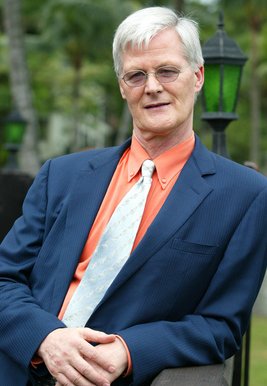
In his Guest Editor letter to our readers,
Canadian nutritionist Udo Erasmus talks about life,
and how to know if we are living up to its potential.
The LIFECO ARTICLES Index
Healthy fats guru Udo Erasmus talks about pain
being a catalyst to make positive changes in our life.
We can measure everything we think, feel, say and do by one standard – life. But when we live below the standard set by life we experience pain. Pain is a message from life that we need to change.
There are four different forms of pain – heartache, physical pain, mental-emotional pain and environmental pain. Each form expresses itself differently, but they are all life alerting us to set better standards.
Heartache
Heartache is our life calling to us to be fulfilled.
 This is our core pain. It is not well understood, although poets, bards, writers, sages, and masters regularly address this theme. We often blame our core pain on other people or on situations past or present.
This is our core pain. It is not well understood, although poets, bards, writers, sages, and masters regularly address this theme. We often blame our core pain on other people or on situations past or present.
The truth is this pain, (also called loneliness, longing, ennui, emptiness, uneasiness, sorrow, and many other names) is the pain of our disconnection from the core of our being and the feeling of our inner essence. This disconnection is a natural part of getting to know the world. What is unnatural is that so few people find their way back to themselves.
Heartache is the call of our heart for our (not someone or something else’s) attention. The call is subtle, persistent, and sometimes very intense. If we acknowledge this call, it will lead us back to our heart. With a little help from those who know, the heartache will turn into an intense joy with life, a deep and solid contentment, or the feeling that we are wonderfully and unconditionally cared for. We feel fulfilled, inspired and even find our true passion.
Someone once told me that a life of purpose requires a personal experience of the divine. I believe that although we usually leave this to last, the feeling of living fully present, aligned with life, is really the starting point of a life of wholeness.
Physical Pain
This means to eat, drink, and breathe to higher standards, avoid poisons, ensure optimum digestion, and move without bashing into physical obstacles. 
The pain of degenerative diseases is largely based on inflammation triggered by not getting enough good food and essential nutrients, while getting too many carbohydrates, toxic molecules (industrial chemicals, plastics, pharmaceutical drugs, pesticides, heavy metals), processing- or food preparation-damaged food molecules, too much toxic radiation, and taking too little care of our digestion. Inflammation puts pressure on nerve endings which triggers physical pain.
Secondary to inadequate physical standards are viral, yeast, fungal, and bacterial infections. Inflammation also triggers pain from infections. The pain reminds us to set higher standards.
Mental-Emotional Pain
Negative thoughts and emotions can lead to actions that are out of line with life, others or nature, which threatens our survival. Because survival is threatened, life lets us know through pain that we need to choose better thoughts, emotions, and actions.
Positive thoughts and emotions toward life, others, and the planet lead to better outcomes, and therefore bring pleasure rather than pain. Inherent in our mental and emotional make-up is the need to contribute. We feel better when we help or heal than when we hurt or damage life, others, or the planet.
Wisdom comes from living in line with life from within and by respecting and accepting others and nature. Wisdom expresses itself in taking no more than we need and giving what we can to those around us.
Environmental Pain
Grow organic. Avoid the use and consequent intake of industrial chemicals. If they create pain in the environment, they will create pain in the body.

If we burn up our oxygen, we asphyxiate ourselves. It took the plants that made our fossil fuels 2.5 billion years to create enough oxygen on this planet for air-breathing creatures to begin to exist. The burial of fossil fuels made it possible for high levels of oxygen to remain in our atmosphere. If we dig out and burn all the fossil fuel, we will use up most of the oxygen, and then it’s goodbye humans, mammals, birds, reptiles, fish, and invertebrates (flies, bees, wasps, spiders, and many more).
When we burn coal, gas, kerosene, gasoline, bio-ethanol or similar bio-fuels, each atom of carbon removes two atoms of oxygen (to make carbon dioxide) from our atmosphere. Burning fossil fuels also costs us one atom of oxygen for each two hydrogen atoms (to make water). The depletion of oxygen, more than carbon dioxide production, is the long-term, irreversible consequence of our use of carbon-based fuels.
Only green plants can turn carbon dioxide back into oxygen. They’ve been doing it for 4.5 billion years. They’re dependable and time-tested. We hurt them at our peril. We need them for everything, and they need us for nothing. Who do we think is in charge here?
 Water is the only non-polluting, sustainable source of energy that suspends all of the problems caused by fossil fuels, explosives, and fires. We can run everything on the ground on hydro-electricity. We can make fuel by using some of this electricity to split water into hydrogen and oxygen. We can store water and irrigate dry places to make them green. Water is necessary for growing food, retaining water in the ground, and allowing green plants to turn carbon dioxide back into oxygen. Water is therefore necessary for hunger, thirst, and breath. We should be in awe of water.
Water is the only non-polluting, sustainable source of energy that suspends all of the problems caused by fossil fuels, explosives, and fires. We can run everything on the ground on hydro-electricity. We can make fuel by using some of this electricity to split water into hydrogen and oxygen. We can store water and irrigate dry places to make them green. Water is necessary for growing food, retaining water in the ground, and allowing green plants to turn carbon dioxide back into oxygen. Water is therefore necessary for hunger, thirst, and breath. We should be in awe of water.
If we pollute our water, we drink our pollution. Human wastes harbor infectious bacteria and parasites. Instead of cooking our food and destroying its nutritional value, we should cook our wastes to destroy parasites and infectious (unfriendly) microorganisms. Then we should return these wastes to the land, because they are the soil that became food that was used to make our bodies.
When we take soil from the land and flush it into rivers that take it to the oceans, we are ruining the land that grows our food and sustains our bodies. Research suggests that it takes 100 years to make an inch of topsoil. Plants take 20 essential minerals from the soil. Our fertilizers replace only 3 to 6. There are indications that we cut the mineral content of our soils in half about every 50 years. How long can we continue to do this?
We were invited to partake of the dance, not to destroy the dancers.
